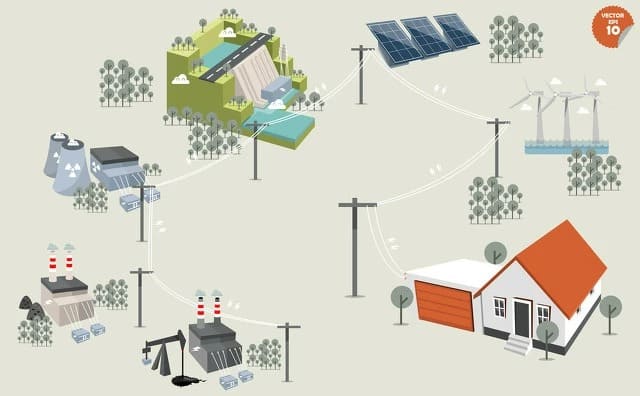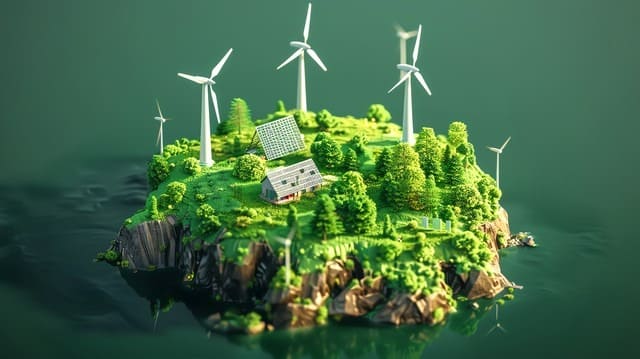1、The key aspects for determining space requirements for a home wind power system are:
Wind turbine dimensions
Common sizes for home wind turbines range from 1 to 10 kilowatts. Small 1-3 kW wind turbines are usually around 3-6 meters in diameter, while large 5-10 kW wind turbines are around 6-12 meters in diameter. Therefore, the amount of horizontal space required depends on the size of the wind turbine.
Installation height
The efficiency of wind power generation is closely related to the installation height. Typically, the higher the wind turbine installation height, the higher the power generation efficiency. The installation height of home wind power generation systems is generally between 10-30 meters. This requires sufficient vertical space to install the wind turbine.

Surroundings
The installation location of home wind power generation systems also needs to consider surrounding environmental factors, such as buildings, trees, terrain, etc. These factors will affect the utilization of wind resources, so a certain buffer space needs to be reserved. Generally speaking, a minimum of 2-3 times the diameter of the turbine is required around a wind turbine.
Taking the above factors into consideration, a typical 3kW home wind power generation system requires approximately:
Horizontal space: about 6 meters in diameter
Vertical space: Installation height is about 15 meters
Surrounding buffer space: about 18 meters in diameter
2、Other factors affecting home wind power system space requirements
In addition to factors such as the size of the wind turbine, installation height and surrounding environment, there are other factors that affect the amount of space required for a home wind power system:
Household electricity needs
The electricity demand of different households is different, which directly determines the size of the wind power generation system required. A home that uses more electricity may need a more powerful wind turbine, which requires a larger installation space. On the other hand, households with smaller electricity needs can choose smaller power wind turbines, and the space requirements will be relatively smaller.
Usable roof or site area
Some homes may not have enough roof or site area to install a large wind power system. In this case, smaller wind turbines need to be selected to adapt to limited space conditions.
Local planning and restrictions
Different regions or communities may have restrictions and requirements on the installation height and appearance of home wind power systems. These plans and constraints also affect the specific design and space required of the system.
Auxiliary equipment needs
In addition to the wind turbine itself, home wind power generation systems also need to be equipped with auxiliary equipment such as controllers and battery packs. The size and layout of these devices also take up some space.
3、How to reasonably plan the space of a home wind power generation system
To determine the space required for a home wind power generation system, we can take the following suggestions:
Assess household electricity needs first
By analyzing household electricity consumption habits and electricity consumption, the scale of the required wind power generation system can be initially determined, thereby providing a basis for subsequent space planning.
Choosing the right wind turbine
Choose the right size wind turbine based on your power needs and available space. Generally speaking, the more powerful the turbine, the larger the space required.
Properly arrange equipment layout
In addition to the wind turbine itself, the layout of auxiliary equipment such as controllers and battery packs must also be considered. Centralized or decentralized layout can be adopted to rationally utilize the available space.
Make full use of rooftop or site space
For limited installation space, consider utilizing vertical space on the roof or other sites to maximize the use of available space.
4、Future Development Trends
With the continuous advancement of renewable energy technology and people’s increasing awareness of environmental protection, home wind power generation systems will surely usher in broader development prospects in the future. From the perspective of space demand, we can foresee the following development trends:
Miniaturization and integration
In the future, household wind power equipment will tend to be more compact and compact, and at the same time realize the integration of functions. For example, turbines, controllers and other equipment can be integrated together to significantly reduce the occupied space. This will allow home wind power systems to adapt to smaller installation environments.
Vertical wind power generation
With the advancement of technology, the performance of vertical axis wind turbines is also constantly improving. This vertical wind turbine is smaller in size, more flexible in installation, and can better fit into limited spaces in cities or suburbs.
Hybrid power generation system
Homes in the future may use a hybrid system of multiple renewable energy technologies, such as wind and solar power. This hybrid system can make full use of the advantages of different energy sources to achieve more efficient power generation in a limited space.
Energy storage technology progress
As batteries and other energy storage technologies continue to advance, home wind power systems will be able to be equipped with more efficient energy storage equipment. This will greatly improve the power supply reliability of the system and also make better use of the limited installation space.
Intelligent control technology
In the future, home wind power generation systems will surely adopt more intelligent control technology to achieve automated operation and optimized management. This will allow the system to achieve maximum performance in a limited space.
In general, with the continuous advancement of related technologies, future home wind power systems will be more compact, efficient, and intelligent, and can better adapt to the limited installation space of homes and meet the electricity needs of home users. This will provide household users with better quality renewable energy supply options.
5、Frequently Asked Questions
In the process of discussing the space requirements of home wind power generation systems, we will also encounter some common questions. Let us answer them together:
Question 1: Is there enough space on the roof of a home to install a wind turbine?
Answer: This depends on the specific situation. Generally speaking, roof space is the preferred location for home installation of wind turbines. However, if the roof area is small, or the surrounding environment is not ideal (such as being blocked by buildings or trees, etc.), the required space conditions may not be met. In this case, you can consider using other venues such as courtyards and open spaces for installation.
Question 2: How to determine the minimum space required?
A: The key to determining the minimum space required is an accurate assessment of the home’s electrical needs. Determine the appropriate wind turbine specifications based on the power demand, and then combine the unit size, installation height and surrounding environmental factors to estimate the minimum space required. Generally speaking, a cylindrical space with a diameter of 15-25 meters and a height of 15-25 meters can meet the needs of most families.
Question 3: If space is limited, are there any alternatives?
Answer: If the space available to your family is indeed very limited, here are a few alternatives to consider:
Choose smaller power wind turbines to adapt to limited space conditions
Using a vertical axis wind turbine, its size is smaller and its installation is more flexible
Integrating wind power systems with other renewable energy technologies such as solar power
Make more reasonable planning and utilization of existing space
Question 4: Will installing a wind turbine affect the structure of the house?
Answer: If you choose a suitable wind turbine model and install it reliably as required, it will generally not have much impact on the structure of the house. However, before installation, you still need to consult a professional engineer to ensure the safety and reliability of the system.
In general, as long as reasonable planning is carried out according to the specific situation, the home wind power generation system can be well applied in a limited space. The key is to fully understand your needs, choose the right equipment, and make wise use of the available space.
Learn More:Dynamic Influences of Wind Power on The Power System — Welcome to DTU Research Database

